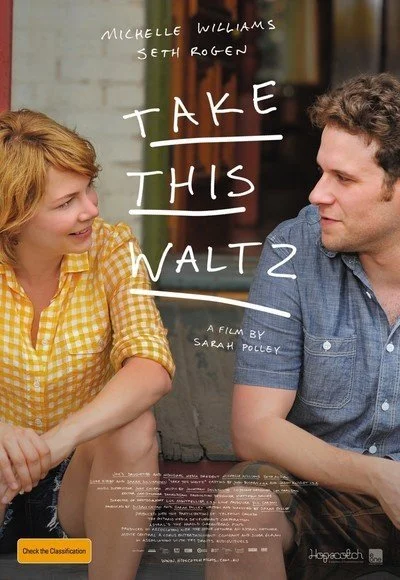
Take This Waltz
Written and directed by: Sarah Polley
Starring: Michelle Williams, Seth Rogen, Luke Kirby and Sarah Silverman
Before You Watch
〰️
Before You Watch 〰️
There’s a scene in the 1996 Janeane Garofalo movie, The Truth About Cats and Dogs, where the two central female characters, played by Garofalo and Uma Thurman, are staring at themselves in the mirror. They’re apart but the scene is edited so that their faces start to blend into the other as they stare at themselves in the mirror. And in a voice over, we hear Thurman’s character say, “Did you ever look in the mirror so long that your face didn't make sense anymore? It just becomes all these shapes. Just shapes. Not good or bad.”
I think about that scene often. In The Truth About Cats and Dogs, the scene is meant to represent how much judgment and criticism we bring to our bodies, when our bodies simply just are. But I often think of that scene when I’m feeling lost and disconnected, when I don’t recognize myself, and when I’ve grown sick of myself and the feeling of loneliness that I’ve carried with me since I was a child. I’ve looked everywhere to try and fill it. I’ve tried to fill it with books, with movies, with food, with drugs, with alcohol, but perhaps most destructively, with people.
Trying to fill my loneliness with other people has had terrible consequences, for them and for myself, and with each new relationship, I’m left feeling even more lost and lonely than when I began.
Question to hold as you watch:
Have there been moments in your life where you’ve felt empty inside?
What have you done to fill the emptiness?
After the Movie
〰️
After the Movie 〰️
In an interview after Take This Waltz was released, writer-director Sarah Polley talked about how she wanted to make a movie that captured “the concept of emptiness and about life having a gap in it.”
In the movie we see Margot, played by Michelle Williams, anxiously wrestling with that feeling of emptiness – and the isolation it brings – inside her. She’s so uncomfortable with it, and the way that it takes up space in her marriage to Lou, played by Seth Rogen, that she is constantly trying to silly-her-way-out-of-it. We see her cling to Lou almost as if she were a child, trying desperately to have the love between them be enough to fill the loneliness that she feels. And then a new distraction comes along in the form of Daniel, played by Luke Kirby, a sexy and mysterious artist who also happens to live on their street.
In so many ways, the story of Margot and Lou and Daniel is the stuff of cliches, of quarter-life crises’ and affairs and avoidance. But what makes Take This Waltz so powerful and unique is that it goes beyond the cliches to raise questions that are so rarely asked but always present, such as:
Why are we always attracted to the new? Is long term monogamy possible? Or does it stifle our growth and fall under archaic laws of ownership? And perhaps most interestingly, what do we do with the loneliness that we carry?
The movie begins and ends with the same scene, of Margot in the kitchen, looking forlorn, lost and overwhelmed, and Polley has said that she did that so that what happens in the middle, between that first and last scene, is her “upending her entire life to try and avoid that very feeling.” Take This Waltz is a reminder of what happens when we try to deny the inherent loneliness we all carry as individuals, the loneliness of what it is to be a person in this world, and what happens when we try to outrun that feeling by running to someone else.


